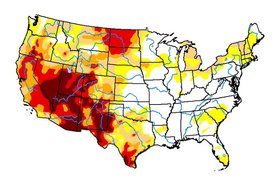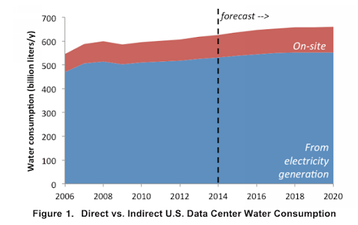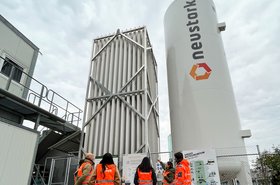As explosive growth of the data center industry continues, and the definition of “sustainable” operations evolves, water management approaches must adapt for long-term reliable operation and stewardship of finite water resources
Introduction
A strong water management program for any industry is generally comprised of two basic elements:
- quantification of water quantity and quality needs (“water use”), and
- assessment and mitigation of water related risks.
This approach works well to prevent water-related disruption to operations. However, it does not consider the role and responsibility of industry’s water use within a watershed and a community.
Increasingly, industry is looking beyond water management to broader water stewardship by contemplating actions to replenish the water resources they consume and contribute to the overall health of the watershed. This three-part series examines current water management practices in the data center industry, management of the risks water poses to data center operations, and the challenges and opportunities as more data center operators consider commitments to water replenishment.
Water use in data centers – definition and quantification
The equipment within data centers generates heat that must be managed to maintain operation below the thresholds at which equipment failure rates begin to increase. Evaporative cooling remains the most common cooling method employed, with system designs differing based on climate. Some require more water than others but all result in evaporative losses and thus, consumptive water use.
One of the key factors that determines the quantity of water required in cooling systems is the water quality of the source water. The better the water quality (e.g., low hardness, dissolved solids, and silica), the more times the water can be cycled within the system [referred to as cycles of concentration (CoCs)] and the less water is required to remove the same heat load. After some cycling within the system, the water will reach a threshold concentration--electrical conductivity is commonly used as an indicator-- and will need to be discharged before precipitation and scaling within the cooling system occurs. The “blowdown” water that is discharged can vary widely in quality depending on the quality of the source water and the number of CoCs within the system. Depending on the water quality of the blowdown, it may be treated onsite and reused, discharged to surface water, discharged to a local sanitary sewer for subsequent treatment and discharge, or reused for a secondary beneficial purpose with or without treatment, such as irrigation of agriculture.
Water use metrics and key performance indicators
Much attention has been paid to the power used by the data center industry but, until recently, comparatively little has been published regarding data center water use. The use of power and water in a data center are closely tied - cooling technologies requiring less power generally need more water and vice versa. Data center operators must find the right blend of cooling technologies to balance these resources for their site based on availability, cost, and competing needs in the community.
The primary metric currently in use to define data center water consumption is water usage effectiveness (WUE), first defined by the Green Grid (Patterson, 2011) and now being further developed by International Organization for Standardization (ISO, 2021). WUE is defined as: WUE = Actual Site Water Usage / Information Technology Equipment Energy
The units of WUE are liters/kilowatt-hour (L/kWh). However, this metric has several limitations:
- Total vs. consumptive use.
The metric defines “actual site water usage” as all the water being supplied to the data center. It does not consider the number of CoCs or the consumptive (evaporative) water use. - No “credit” for the use of alternative water sources.
Does not address the use of non-potable waters in cooling (such as reclaimed municipal wastewater). - No “credit” for beneficial reuse.
In some cases, the blowdown is beneficially reused (either with or without treatment). WUE does not provide a means of accounting for this. - No “credit” for return of water to source after use.
In some cases, the blowdown is treated and returned to the source. If it is assumed that the water quality of this return water is in compliance with applicable water quality standards, it could be argued that the volume returned should be excluded from the WUE calculation as a credit.
In addition to the above limitations, WUE also does not account for the water use associated with the power source for the data center. An additional metric (WUEsource) was proposed at the same time as WUE (Patterson, 2011) to account for this: WUEsource = ( Actual Site Annual Source Energy Water Usage + Annual Site Water Use ) / Information Technology Equipment Energy
However, WUEsource is not widely used as water usage associated with power production can be difficult to quantify. Data centers often use energy from multiple different sources (e.g., wind, solar, natural gas, etc.) that can have high seasonal variability (i.e., less solar during winter months). The real-time water intensity of these various sources and technologies is not generally available.
A 2016 study by Lawrence Berkeley National Laboratory (Shehabi, 2016) reported the average data center WUE in the United States to be 1.8 liters (0.46 gallons) of water per kWh of total data center site energy use. For a typical 100 MW data center, this translates to 1.1 million gallons of water per day. The same study also estimated the indirect water use of data centers from energy production and found that source energy water usage was significantly greater than the amount of water used onsite (Figure 1).
As shown, water is essential in the operation of most data centers. When the available quantity or quality of water changes, there is an immediate and direct impact to data center operations. Anticipating and mitigating water related risks can prevent unexpected outages and facilitate continued growth.
Next Week: Part 2 of 3 - Management of water risks to data center operations
Rebecca Maco is a project manager and process engineer with over 20 years of experience.
Thomas Steinwinder leads Brown and Caldwell’s data center & mission critical water business
Dr. Carla De Las Casas is Brown and Caldwell’s data center water leader.
References
- International Organization for Standardization (ISO). Information technology - Data centres key performance indicators - Part 9: Water Usage Effectiveness (WUE). “Under Development” as of June 2021.
- Patterson, M. Water usage effectiveness (WUE): a greed grid data center sustainability metric. Tech Rep. WP35, The Green Grid. 2011.
- Shehabi, Arman et al. United States Data Center Energy Usage Report. Ernest Orlando Lawrence Berkeley National Laboratory. June 2016
Read the series:








